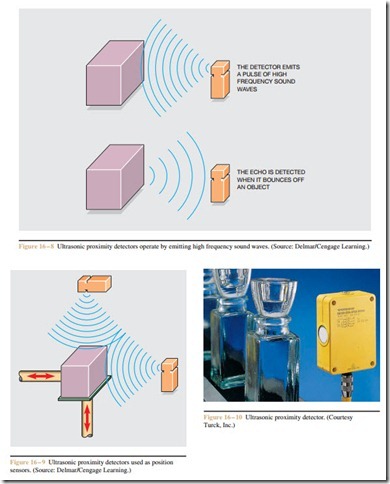Ultrasonic Proximity Detectors
Another type of proximity detector that does not depend on the presence of metal for operation is the ultrasonic detector. Ultrasonic detectors operate by emitting a pulse of high frequency sound and then detecting the echo when it bounces off an object (Figure 16 – 8). These detectors can be used to determine the distance to the object by measuring the time interval between the emission of the pulse and the return of the echo. Many ultrasonic sensors have an analog output of voltage or current, the value of which is determined by the distance to the object. This feature permits them to be used in applications where it is necessary to sense the position of an object (Figure 16 – 9). An ultrasonic proximity detector is shown in Figure 16 – 10.
Review Questions
1. Proximity detectors are basically
2. What is the basic principle of operation used with detectors designed to detect only ferrous metals?
3. What is the basic principle of operation used with detectors designed to detect all types of metals?
4. What type of electric circuit is used to increase the sensitivity of the proximity detector?
5. What type of proximity detector uses an oscillator that operates at radio frequencies?
6. Name two types of proximity detectors that can be used to detect objects not made of metal.
7. What is the maximum range at which most capaci- tive proximity detectors can be used to sense an object?
8. How is it possible for an ultrasonic proximity detector to measure the distance to an object?
